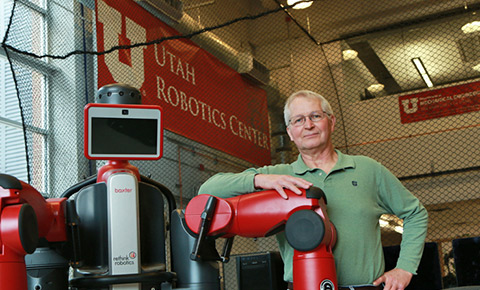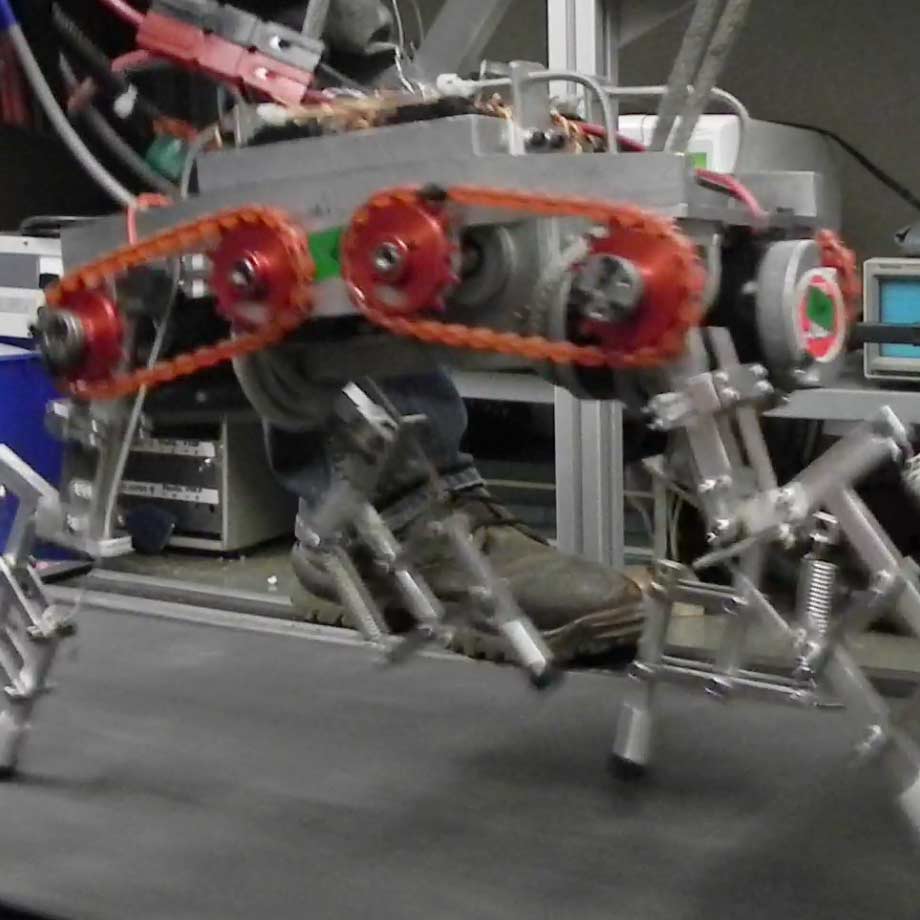Dr. Andrew Petruska has accepted an offer to join the faculty of the Department of Mechanical Engineering at the Colorado School of Mines. Congratulations Andrew! He and his wife are very excited to start their new life in Colorado. Andrew earned a B.S. in Physics, a B.S./M.S. in Mechanical Engineering (ME) from Carnegie Mellon University, and his Ph.D. in ME (Robotics track) in 2014 under the supervision of Prof. Jake Abbott. Before starting his Ph.D. work, he spent four years in the defense industry working on ordnance and control systems for solid rocket motors. At the University of Utah he...
Read MoreChris Pratt’s ICRA paper and video make the final cut of ICRA 2016 Video Trailer Episode I — Flying Robots!
Robotics graduate student Chris Pratt and Prof. Kam Leang’s ICRA paper and video make the final cut of ICRA 2016 Video Trailer Episode I — Flying Robots! Paper is entitled, “Dynamic Underactuated Flying-Walking (DUCK) Robot” Details can be found here: http://trailer.icra2016.org/...
Read MoreThe University of Utah Robotics Center launches!
The Utah State Board of Regents recently approved the University of Utah Robotics Center (UURC). The UURC consists of faculty and graduate students from the School of Computing and the Department of Mechanical Engineering. The UURC is also pleased to jointly offer the second graduate program in robotics in the US, with a curriculum that imparts fundamental knowledge about robotics and specific courses in perception, cognition, and action. Read full story here…...
Read MoreProf. John Hollerbach named IEEE Life Fellow
Congratulations to Prof. John Hollerbach! He was recently named IEEE Life Fellow (in January), for his contributions in the robotics field and involvement with IEEE. Professor Hollerbach’s research involves robotics, virtual environments, and human motor control. He is also the Editor of the International Journal of Robotics Research, one of the top journals in robotics. ...
Read MoreProf. Jake Abbott receives funding for two-handed large-workspace haptic interface
The Utah Robotics Center recently added two 7-degree-of-freedom Quanser HD^2 haptic interfaces to the shared Large Robotics Lab (valued at $191,800). This equipment purchase was made possible with an award from the University of Utah Research Instrumentation Fund, lead by Prof. Jake Abbott, combined with generous academic discounts from Quanser. A haptic interface is a robotic force-feedback human-input device used to interact with virtual environments and teleoperate remote robotic systems. The haptic interface system will support research from robot-assisted retinal microsurgery to robotics for nuclear applications and nuclear facilities. The new equipment will be shared by the Robotics faculty in the Department...
Read MoreJake Abbott 2014 Researcher of the Year
Based on annual faculty activity report data, as well as proposal and grant data, the Department of Mechanical Engineering is pleased to recognize Prof. Jake Abbott as our researcher of the year. Jake is well-known in the robotics community for his work on magnetic manipulation, haptics, and telerobotics. The application of his work includes medical microrobots, magnetic guidance of a cochlear implant and robot-assisted rehabilitation. For more information about Jake’s research, visit http://www.telerobotics.utah.edu....
Read MoreProf. Leang and collaborators receive new $3.8M NSF funding to work on electroactive polymer materials for soft robotics
Kam Leang in collaboration with UNLV-led team (Kwang J. Kim and Paul Oh) and other researchers receive new $3.8M NSF funding to work on electroactive polymer materials for soft robotics. Goal and Objectives: This international project addresses a technologically important issues in soft robotics. Soft robotics is an important emerging field in robotics, mechatronics, and automation. Soft robotic components and systems offer new features and advances over conventional robotic devices. This project focuses on the creation of advanced multifunctional artificial muscles (AM) based on new polymer-metal composites which can be used in soft robotic applications. Artificial muscles can be transformative for...
Read MoreProf. Meek receives new NIH grant to work on Quadrupedal Human-Assistive Robotic Platform (Q-HARP)
NRI: Collaborative Research: Quadrupedal Human-Assistive Robotic Platform (Q-HARP) Prof. Meek receives new 3-year $119,523 NIH grant to work on Quadrupedal Human-Assistive Robotic Platform (Q-HARP). Aging of the population has become a long-term trend in the United States. According to The State of Aging and Health in America, the U.S. population aged 65 and older is expected to double during the 25 years following 2007, and there will be 71 million American older adults, accounting for approximately 20% of the U.S. population by 2030. For the health and wellbeing of older adults, a key factor is being physically active. However,...
Read MoreProf. Leang receives NSF grant to work on temporal-spatial control of dual-stage nanopositioning systems
Prof. Leang and collaborators from industry (Molecular Vista, Inc. (MVI)) and Villanova University (Prof. Garrett Clayton) received a new NSF grant ($305,912) from Sensors, Dynamics, & Control program to study new design and control system approaches for the development of advanced nanopositioning systems for nanoscale science and engineering applications. More specifically, the new 3-year NSF collaborative Grant Opportunities for Academic Liaison with Industry (GOALI) research project focuses on new design and control paradigms for dual-stage nanopositioners that consider both spatial and temporal constraints. Emerging dual-stage nanopositioners have the unique ability to achieve both long-range and high-speed operation. However, typical control strategies rely on frequency-based...
Read MoreProf. Meek’s NSF NRI project results in quadruped robot trotting
The video shows the quadruped robot trotting on a treadmill test fixture. The legs have fixed springs. There are no sensors or control except for the motion of the hips and shoulders. This is a demonstration of the passive stability with directionally compliant legs. This research project is led by robotics faculty Prof. Sanford Meek. The project “NSF NRI grant: Biologically-inspired, hybrid quadruped robot control” is sponsored by the National Science Foundation. ...
Read More







